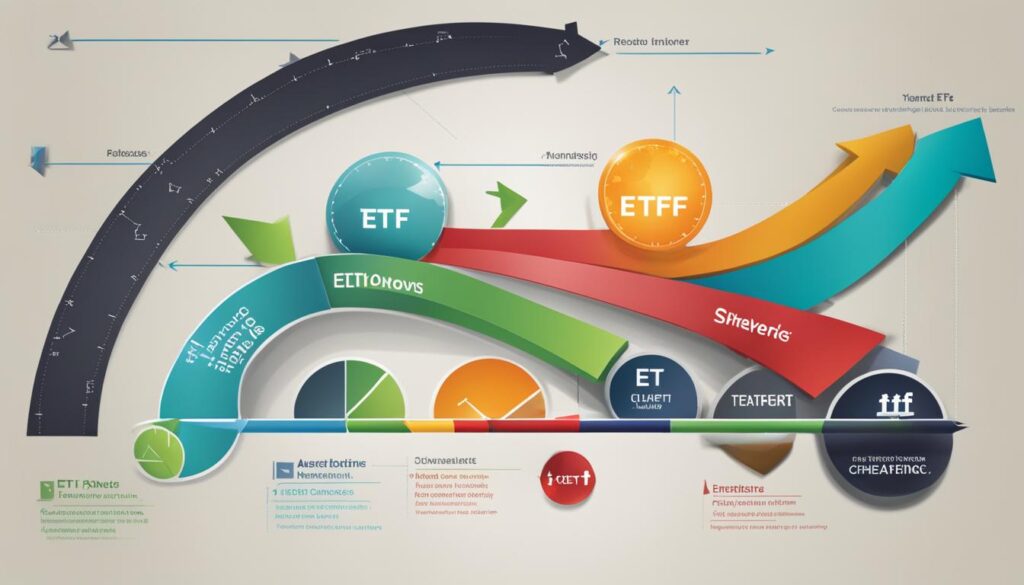Exchange-Traded Funds (ETFs) offer investors a unique investment vehicle that combines the flexibility of stocks with the benefits of market tracking. These investment vehicles trade on exchanges and are designed to track specific indexes, providing investors with the ability to buy and sell shares during market hours. With their diverse range of asset classes and the ability to meet various investment needs, ETFs have become a popular choice among investors looking for a versatile and cost-effective option.
Key Takeaways:
- ETFs combine the flexibility of stocks with the diversification of mutual funds.
- They track specific indexes and can be bought and sold during market hours.
- ETFs provide access to a wide range of asset classes and help diversify portfolios.
- They are often more tax-efficient and cost-effective compared to actively managed mutual funds.
- ETFs offer investors the ability to meet a variety of investment needs.
How Do ETFs Work?
Exchange-Traded Funds, or ETFs, are investment vehicles that provide investors with exposure to a diversified portfolio of assets. ETFs work by tracking specific indexes or holding a collection of stocks, bonds, or other securities. When investors buy shares of an ETF, they are essentially buying a bundle of assets that can be traded like stocks during market hours.
Unlike mutual funds, which are priced at the end of the trading day at a single net asset value (NAV), ETFs can be bought or sold intraday on stock exchanges at different prices. This means that investors have the flexibility to trade ETFs throughout the trading day. The prices of ETFs fluctuate in real-time as the underlying assets in the portfolio change in value.
One of the key advantages of ETFs is their ability to provide portfolio diversification. ETFs offer investors exposure to a wide range of asset classes, including stocks, bonds, commodities, and even specific sectors or industries. By investing in ETFs, investors can gain access to a diversified portfolio with just one investment.
In summary, ETFs work by tracking indexes or holding a collection of securities that can be traded like stocks during market hours. They provide investors with flexibility, as they can be bought and sold throughout the trading day. ETFs also offer diversification by providing exposure to a wide range of asset classes. These features make ETFs a popular choice for investors looking to build a well-rounded portfolio.
Why Invest in ETFs?
There are several reasons why investors choose to invest in ETFs. Firstly, ETFs provide an affordable way to access a diverse mix of asset classes. Whether an investor is interested in domestic or international stocks, bonds, or commodities, ETFs offer a convenient solution. By investing in ETFs, individuals can gain exposure to a wide range of assets without the need for significant capital or the complexity of purchasing individual securities.
Furthermore, ETFs are known for their tax efficiency. Unlike actively managed mutual funds, which often generate taxable capital gains through frequent buying and selling of holdings, ETFs are typically more passively managed. This results in lower portfolio turnover and, consequently, fewer taxable events. As a result, ETFs can be a tax-efficient option for investors looking to maximize their returns.
Another key advantage of ETFs is their ability to meet a variety of investment needs. With thousands of ETFs available in the market, investors can choose funds that align with their specific goals and risk tolerances. Whether an investor is seeking income generation, capital appreciation, or exposure to a particular sector or market, there is likely an ETF that suits their needs. This versatility makes ETFs a valuable tool for building a well-diversified portfolio.
| Advantages of Investing in ETFs | |
|---|---|
| 1. Affordable access to a diverse mix of asset classes | 4. Tax efficiency compared to mutual funds |
| 2. Ability to meet a variety of investment needs | 5. High liquidity and ease of trading |
| 3. Low expense ratios compared to actively managed mutual funds | 6. Potential for enhanced portfolio diversification |
Overall, ETFs are an attractive investment option for individuals looking to build a well-rounded portfolio. With their affordability, tax efficiency, and versatility, ETFs offer investors the opportunity to diversify their holdings and meet their specific investment needs.

Comparing ETFs and Mutual Funds
ETFs and mutual funds are popular investment options that offer different features and benefits to investors. While both investment vehicles provide access to a diversified portfolio, there are several key differences to consider when deciding which option is right for you.
Similarities and Differences
ETFs and mutual funds are similar in that they both represent baskets of individual securities. However, there are important distinctions between the two. One key difference is the method of trading. ETFs can be bought or sold throughout the trading day at market prices, while mutual funds are priced once at the end of the trading day. This intraday trading feature of ETFs provides flexibility and allows investors to react quickly to market changes.
Expense ratios are another significant difference between ETFs and mutual funds. ETFs are often passively managed and aim to replicate the performance of an index, resulting in lower expense ratios compared to actively managed mutual funds. This means that investors in ETFs typically pay lower fees for asset management.
Daily Transparency and Liquidity
ETFs offer daily transparency of their holdings, meaning that investors can easily see the underlying assets and the weightings within the ETF. This transparency allows investors to make informed decisions based on the ETF’s composition. Mutual funds, on the other hand, disclose their holdings less frequently, often on a monthly or quarterly basis.
Another advantage of ETFs is their liquidity. Being traded on stock exchanges, ETFs can be easily bought or sold at market prices throughout the trading day. Mutual funds, in contrast, are bought or sold at the net asset value (NAV) calculated at the end of the trading day. This means that investors in ETFs have more control over their trades and can take advantage of market opportunities as they arise.
| Comparison | ETFs | Mutual Funds |
|---|---|---|
| Trading | Intraday trading at market prices | End-of-day trading at NAV |
| Expense Ratios | Lower expense ratios | Higher expense ratios |
| Transparency | Daily disclosure of holdings | Less frequent disclosure of holdings |
| Liquidity | High liquidity throughout the trading day | Traded at NAV at the end of the trading day |
Table: A comparison of ETFs and mutual funds highlighting key differences in trading, expense ratios, transparency, and liquidity.
When considering whether to invest in ETFs or mutual funds, it’s important to evaluate your investment goals, trading preferences, and risk tolerance. ETFs provide intraday trading, lower expense ratios, daily transparency, and high liquidity. On the other hand, mutual funds may be preferred for investors who value a hands-off approach to investing and are willing to pay higher expense ratios for active management.
Costs Associated with ETFs
Investing in ETFs can be an attractive option for many investors due to their flexibility and potential for diversification. However, it’s important to understand the costs involved in owning and trading ETFs. These costs can include brokerage fees, management fees, trading costs, bid/ask spreads, and changes in the net asset value (NAV). Let’s take a closer look at these costs and how they can impact your investment.
Brokerage Fees
When buying or selling ETFs, investors may incur brokerage fees charged by their brokerage company. These fees can vary depending on the brokerage and the number of trades made. Some brokerages offer commission-free ETF trading, while others charge a fee per trade. It’s important to consider these fees when selecting a brokerage to ensure they align with your investment strategy and trading frequency.
Management Fees
ETFs generally have ongoing management fees that are charged by the fund’s sponsor. These fees are typically expressed as a percentage of the ETF’s assets under management (AUM). Management fees cover the costs associated with portfolio management, administration, and other operational expenses. It’s important to research and compare management fees when considering different ETF options to ensure you’re getting value for your investment.
Trading Costs and Bid/Ask Spreads
In addition to brokerage fees, investors may also incur trading costs when buying or selling ETFs. These costs can include bid/ask spreads, which are the difference between the price at which an ETF can be bought (ask) and sold (bid). The bid/ask spread represents the cost of executing a trade and can vary depending on market conditions and liquidity. It’s important to be aware of these costs and consider them when determining the overall expense of trading ETFs.
Additionally, changes in an ETF’s net asset value (NAV) can impact trading costs. The NAV represents the total value of the ETF’s underlying assets divided by the number of shares outstanding. If an ETF’s NAV deviates significantly from its market price, investors may experience additional costs when buying or selling shares to align with the NAV.
Understanding the costs associated with ETFs is crucial for investors to make informed decisions. By considering brokerage fees, management fees, trading costs, bid/ask spreads, and changes in NAV, investors can assess the overall expense of owning and trading ETFs and incorporate these costs into their investment strategy.
| Costs | Description |
|---|---|
| Brokerage Fees | Fees charged by the brokerage company for buying or selling ETFs. |
| Management Fees | Ongoing fees charged by the ETF’s sponsor for managing the fund. |
| Trading Costs | Costs associated with executing trades, including bid/ask spreads. |
| Net Asset Value (NAV) Changes | Impact on trading costs when an ETF’s NAV deviates from its market price. |
It’s important for investors to carefully consider these costs and assess their impact on their investment goals and overall portfolio performance. By understanding and factoring in these costs, investors can make informed decisions when selecting and trading ETFs.
Conclusion
Exchange-Traded Funds (ETFs) are an exceptional investment vehicle that offers numerous advantages. The key strengths of ETFs include their ability to combine the flexibility of stocks with the diversification of mutual funds, making them an attractive choice for investors. ETFs provide easy access to diversified portfolios, allowing investors to gain exposure to a wide range of asset classes. This diversification helps to mitigate risk and enhance the potential for returns.
One of the major advantages of ETFs is their cost-effectiveness. With lower expense ratios compared to actively managed mutual funds, ETFs offer investors a more affordable option for their investments. Additionally, ETFs are highly liquid, allowing investors to buy and sell shares at market prices throughout the trading day. This ease of trading provides investors with the ability to react quickly to market conditions and make timely investment decisions.
However, it’s important to consider the potential disadvantages of ETFs. Some ETFs can exhibit intraday price volatility, which may introduce short-term fluctuations in value. Furthermore, certain complex ETFs may have unique risks and complexities that investors need to be aware of. Therefore, it is essential for investors to thoroughly research and understand the specific ETFs they are considering before investing.
In summary, ETFs serve as a valuable investment vehicle offering numerous benefits, such as diversification, ease of trading, cost efficiency, and liquidity. While they may have some disadvantages, a well-informed investor can utilize ETFs effectively as part of a diversified investment strategy. By carefully assessing the advantages and disadvantages, investors can take full advantage of the opportunities that ETFs offer in the pursuit of their financial goals.
FAQ
What are ETFs?
Exchange-Traded Funds, or ETFs, are investment vehicles that combine the flexibility of stocks with the diversification of mutual funds. They trade on exchanges and track specific indexes, allowing investors to buy and sell shares during market hours.
How do ETFs work?
ETFs work by tracking specific indexes or holding a collection of stocks, bonds, or other securities. When investors buy shares of an ETF, they are buying a bundle of assets that can be traded like stocks during market hours. ETFs are traded on stock exchanges and provide investors with the flexibility of individual securities and the diversification of mutual funds.
Why should I invest in ETFs?
ETFs provide an affordable and tax-efficient way to access a diverse mix of asset classes, including domestic and international stocks, bonds, and commodities. They typically have lower expense ratios compared to actively managed mutual funds and are suitable for meeting a variety of investment needs.
How do ETFs compare to mutual funds?
ETFs and mutual funds are similar in that they represent baskets of individual securities. However, ETFs can be bought or sold intraday on stock exchanges at different prices, while mutual funds are traded at the end of the trading day at a single price. ETFs typically have lower expense ratios and provide daily disclosure of their holdings, offering investors transparency and the ability to make informed investment decisions.
What are the costs associated with investing in ETFs?
Investors may incur brokerage fees for buying or selling listed ETFs, which can range from $0 to $20 per trade. ETFs also have ongoing management fees charged by the fund’s sponsor. Additionally, trading costs can include bid/ask spreads and changes in discounts and premiums to an ETF’s net asset value (NAV).
Are there any disadvantages to investing in ETFs?
Some potential disadvantages of ETFs include intraday price volatility and the complexity of certain types of ETFs. It’s important for investors to consider these factors before investing in ETFs.
What Are the Risks Associated with Short Selling in the Market?
Short selling in the market, while potentially profitable, carries several risks. Firstly, the investor risks unlimited losses since there is no upper limit on a stock’s price increase. Secondly, a sudden rise in the stock’s value can lead to margin calls, forcing investors to buy back at a higher price. Finally, short squeezes can occur when many investors try to cover their short positions simultaneously, causing a rapid increase in the stock price. Overall, short selling in the market involves substantial risks that warrant careful consideration.


Pingback: Going Global: Diversifying Your Portfolio with International Stocks – Straight Fire Money